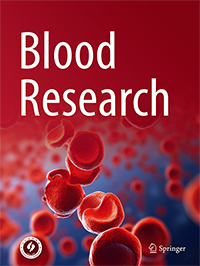Original Article
 Split Viewer
Split Viewer
Blood Res 2016; 51(2):
Published online June 23, 2016
https://doi.org/10.5045/br.2016.51.2.95
© The Korean Society of Hematology
Platelet count recovery after intravenous immunoglobulin predicts a favorable outcome in children with immune thrombocytopenia
Department of Pediatrics, Seoul National University Bundang Hospital, Seongnam, Korea.
Correspondence to : Correspondence to Hyoung Soo Choi, M.D., Ph.D. Department of Pediatrics, Seoul National University Bundang Hospital, 82 Gumi-ro, 173-beon-gil, Bundang-gu, Seongnam 13620, Korea. choihs1786@snubh.org
This is an Open Access article distributed under the terms of the Creative Commons Attribution Non-Commercial License (http://creativecommons.org/licenses/by-nc/4.0) which permits unrestricted non-commercial use, distribution, and reproduction in any medium, provided the original work is properly cited.
Background
Childhood immune thrombocytopenic purpura (ITP) is a common acquired bleeding disorder. Even though most children recover, either spontaneously or with therapy, 10-20% of newly diagnosed ITP cases have a chronic course beyond 12 months. This study evaluated whether clinical and laboratory findings can predict the response to intravenous immunoglobulin (IVIG) and progression to persistent or chronic ITP in children.
Methods
During the period between March 2003 and June 2015, we retrospectively analyzed 72 children, newly diagnosed with ITP, who received IVIG treatment. Peripheral blood counts were obtained at diagnosis and at 1, 3, 6, and 12 months after IVIG treatment.
Results
After 6 months of IVIG treatment, 14 of 72 patients (19.4%) had persistent ITP, and after 12 months, 7 of 40 patients (17.5%) had chronic ITP. Age at diagnosis, gender, history of viral infection, or vaccination before disease onset were not statistically correlated with platelet recovery at 6 and 12 months. However, a platelet count recovery of ≥100×103/µL at 1 and 3 months was significantly correlated with platelet recovery at 6 (
Conclusion
This study demonstrated that early platelet count recovery, at 1 and 3 months after IVIG treatment, predicts a short disease duration and a favorable outcome in children with newly diagnosed ITP. Further investigation in a larger group of patients is warranted to validate these findings.
Keywords Childhood, Immune thrombocytopenia, Intravenous immunoglobulin, Prognostic factor
Article
Original Article
Blood Res 2016; 51(2): 95-101
Published online June 23, 2016 https://doi.org/10.5045/br.2016.51.2.95
Copyright © The Korean Society of Hematology.
Platelet count recovery after intravenous immunoglobulin predicts a favorable outcome in children with immune thrombocytopenia
Hyoung Soo Choi*, Mi Hong Ji, Sung Jin Kim, and Hyo Seop Ahn
Department of Pediatrics, Seoul National University Bundang Hospital, Seongnam, Korea.
Correspondence to: Correspondence to Hyoung Soo Choi, M.D., Ph.D. Department of Pediatrics, Seoul National University Bundang Hospital, 82 Gumi-ro, 173-beon-gil, Bundang-gu, Seongnam 13620, Korea. choihs1786@snubh.org
This is an Open Access article distributed under the terms of the Creative Commons Attribution Non-Commercial License (http://creativecommons.org/licenses/by-nc/4.0) which permits unrestricted non-commercial use, distribution, and reproduction in any medium, provided the original work is properly cited.
Abstract
Background
Childhood immune thrombocytopenic purpura (ITP) is a common acquired bleeding disorder. Even though most children recover, either spontaneously or with therapy, 10-20% of newly diagnosed ITP cases have a chronic course beyond 12 months. This study evaluated whether clinical and laboratory findings can predict the response to intravenous immunoglobulin (IVIG) and progression to persistent or chronic ITP in children.
Methods
During the period between March 2003 and June 2015, we retrospectively analyzed 72 children, newly diagnosed with ITP, who received IVIG treatment. Peripheral blood counts were obtained at diagnosis and at 1, 3, 6, and 12 months after IVIG treatment.
Results
After 6 months of IVIG treatment, 14 of 72 patients (19.4%) had persistent ITP, and after 12 months, 7 of 40 patients (17.5%) had chronic ITP. Age at diagnosis, gender, history of viral infection, or vaccination before disease onset were not statistically correlated with platelet recovery at 6 and 12 months. However, a platelet count recovery of ≥100×103/µL at 1 and 3 months was significantly correlated with platelet recovery at 6 (
Conclusion
This study demonstrated that early platelet count recovery, at 1 and 3 months after IVIG treatment, predicts a short disease duration and a favorable outcome in children with newly diagnosed ITP. Further investigation in a larger group of patients is warranted to validate these findings.
Keywords: Childhood, Immune thrombocytopenia, Intravenous immunoglobulin, Prognostic factor
Fig 1.

Relationship between platelet counts at 1 month and recovery at 6 and 12 months after IVIG treatment.
-
Patient characteristics. Abbreviations: IVIG, intravenous immunoglobulin; WBC, white blood cell..
-
Comparison between the complete response group and the persistent ITP group at 6 months of IVIG treatment. Abbreviations: ITP, immune thrombocytopenic purpura; IVIG, intravenous immunoglobulin; ND, not done; WBC, white blood cell..
-
Comparison between the complete response group and the chronic ITP group at 12 months after IVIG treatment. Abbreviations: ITP, immune thrombocytopenic purpura; IVIG, intravenous immunoglobulin; ND, not done; WBC, white blood cell..

Article Tools
Stats or Metrics
Related articles in BR
-
Prognostic Implication of MDR1 (Multidrug Resistance) Gene Expression in Childhood Acute Leukemia
Hoon Kook, Jun Hee Kim, Chan Jong Kim, Ji Young Park, Chang Yee Cho, Sung Ho Cho, Jung Ah Na, Tai Ju Hwang
Korean J Hematol 1998; 33(3): 334-352 -
Cytotoxic T lymphocyte-associated antigen-4 (CTLA-4) gene polymorphisms in a cohort of Egyptian patients with immune thrombocytopenia (ITP)
Doaa Mohamed El Demerdash, Maha Mohamed Saber, Alia Ayad, Kareeman Gomaa and Mohamed Abdelkader Morad
Blood Res 2024; 59(): -
Recent advances in treatments of adult immune thrombocytopenia
Dae Sik Kim
Blood Res 2022; 57(S1): S112-S119




 PDF
PDF Standard view
Standard view Export citation
Export citation Share
Share  Download
Download Previous Article
Previous Article



